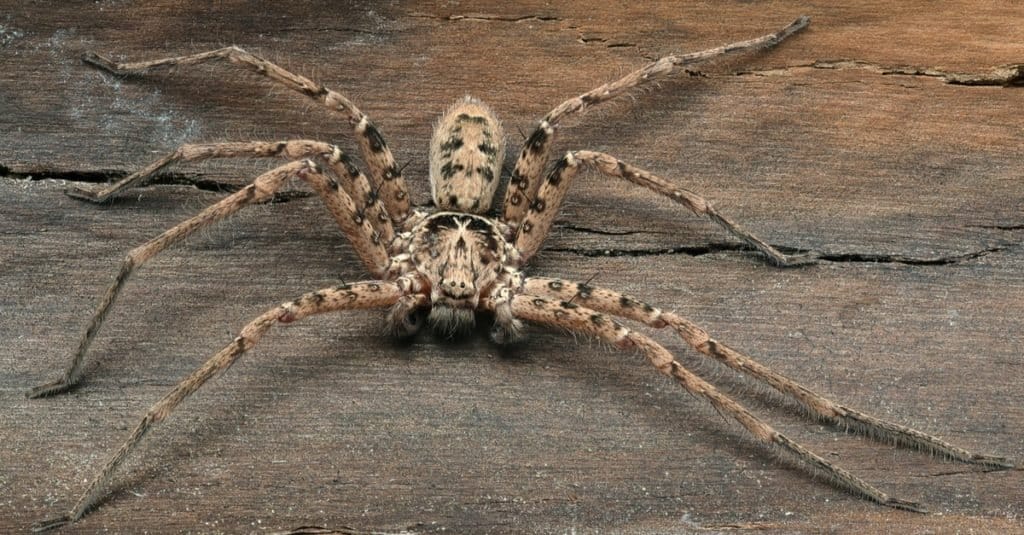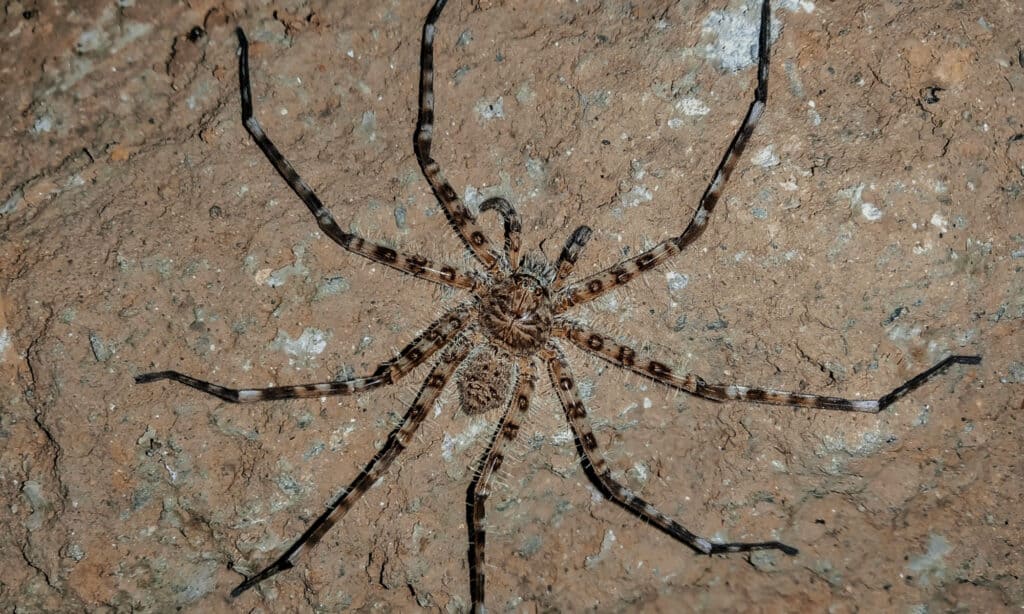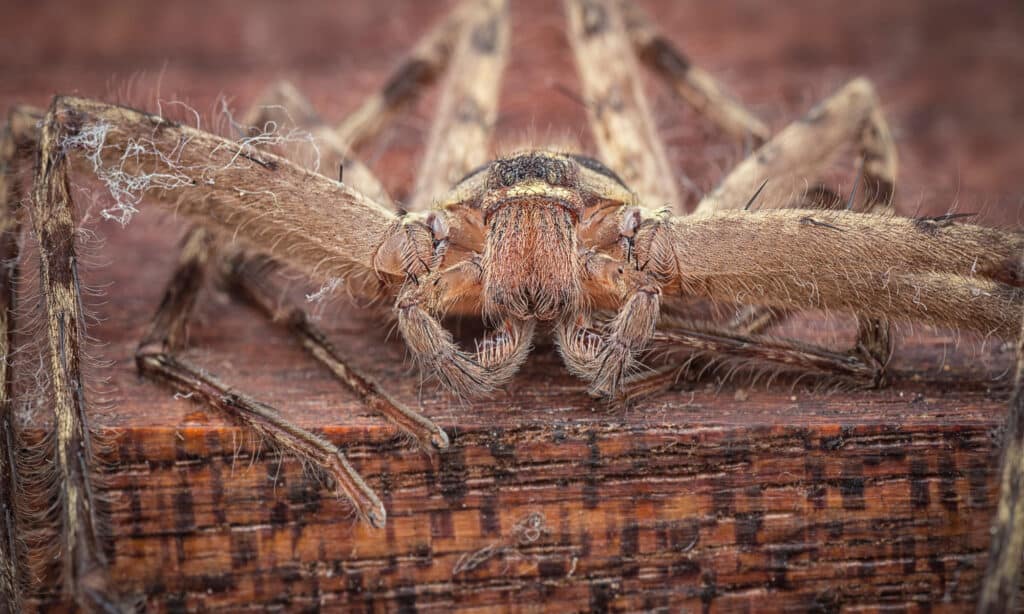Spiders tend to scare even the most level-headed person. Those who may not mind the occasional beetle or ant might lose their head at an eight-legged arachnid. So imagine all that surprise and fear projected ten-fold at the world’s largest spider.
There’s no reason to fear what we do not understand, though that is a natural response to a spider the size of a human head. Despite its unreasonable size, this spider managed to hide for a long time.
Discovered in 2001, the giant huntsman spider lives in the caves of Laos. They are known as the giant crab spiders and have a leg span of up to five inches. The giant huntsman spider can grow to be 12 inches across, which is larger than a human head.
Let’s take a look at some common questions about one of the world’s largest spiders.
How Were Giant Huntsman Spiders Discovered?

The giant huntsman spider was discovered by a professional spider hunter.
©iSKYDANCER/Shutterstock.com
A German scientist named Peter Jäger discovered the giant huntsman spider. He was the head of the arachnology department in the Senckenberg Research Institute, meaning he was particularly well versed in spiders.
Learning that there are people who devote their entire lives to understanding spiders can seem a little strange to some people. But spiders, like all animals in our world, deserve to be known and understood.
There is little information on where precisely the giant huntsman spider thrives, which is on purpose. This is because if people knew where to find them, they could trap them and utilize them for the pet trade. No one wants to be responsible for a spider endemic to Laos spreading its legs across continents.
Of course, extremely large huntsman spiders can be found in other parts of the world, but it’s this species in Laos that – for now – claims the title of the world’s largest spider.
Peter Jäger, the man who discovered these humongous spiders, is well versed in hunting them down. He travels through thick jungle and marshes to get to caves to discover these giant, cave-dwelling arachnids.
Since the giant huntsman spider lives in such remote, hard-to-access environments, it is not surprising that it was able to evade notice until 2001. People don’t regularly frequent the caves of Laos, hoping to find giant spiders. But when they do, they are in luck.
What Do Giant Huntsman Spiders Look Like?

The giant huntsman spider has a flattened appearance and crab-like legs.
©Nikhil Guhagarkar/Shutterstock.com
Often, huntsman spiders are mistaken for being a part of the tarantula family, though they are not. Not all giant and furry spiders are the same.
A great way to identify the giant huntsman spider is by its legs. Instead of their legs folding down under them, they spread outward like a crab’s legs. That’s why they are also known as giant crab spiders.
So picture a giant furry spider with legs spread outward. They can reach a diameter of up to 12 inches, which is larger than a human head! If they were to latch onto your face, you wouldn’t be able to see anything.
The giant huntsman spider is the largest spider based on how far it can spread out, though the goliath birdeater tarantula is the largest by weight. There are many ways to categorize these things.
Another way the giant huntsman spider is unique is that the joints on its legs are twisted. This is what facilitates the crab-like movement of its limbs. Generally, female huntsmans have bigger bodies while male ones have longer legs.
The legs of the giant huntsman are banded in colors, usually gray, brown, or black, while their whole bodies tend to be brown. They look more flattened, unlike your average spider’s general bulbous appearance. This is so that they can squeeze into tighter spaces and chase their prey.
What Do Giant Huntsman Spiders Eat?
If you suffer from arachnophobia, the giant huntsman spider is like something out of your worst nightmares. It is a large, fast-moving spider that thrives in warm, humid climates. They don’t spin webs to catch their prey like the average spider. Instead, they chase their prey.
They can move at a crazy rate of three feet per second and love squeezing their way into small spaces. Large huntsman spiders in Australia have even been known to race across a vehicle’s dashboard after squirreling away somewhere within.
Outside of Laos, other large huntsman spider species live in areas that aren’t full of caves. Huntsman spiders tend to squish themselves behind the bark of trees or beneath rocks and bushes, squeezing into tight places. That’s why finding one where you least expect it can be so startling. While huntsman spiders originated in Asia, they’ve been introduced to many locations across the world including Florida and Texas where they’re often known as “banana spiders.”
Huntsman spiders chase down their prey and bite with strong jaws, injecting a venom that is deadly to much of their prey but not to humans.
What the giant huntsman spider eats is actually a pretty wide variety. It is known to consume other spiders, insects, and even cockroaches. Huntsman spiders, in general, also consume lizards, geckos, and skinks.
Are Giant Huntsman Spiders Dangerous to Humans?

An example of what huntsman spiders look like up close.
©Young Swee Ming/Shutterstock.com
This question is easy to answer: though intimidating to look at, giant huntsman spiders do not pose a danger to humans.
The venom that these spiders inject is not deadly to humans. It is mildly toxic and can cause nausea or a headache, but that will quickly fade. The bites themselves are considered painful though, so it’s not an experience you would want to seek out.
The giant huntsman spider is not trying to hunt man. It is, like any other spider, attempting to live its life and hunt its prey to stay alive. There is nothing inherently dangerous about such a large spider, and it is essential to remember that it wants nothing more than to be on its way and away from humans.
The photo featured at the top of this post is © Nikhil Guhagarkar/Shutterstock.com
Thank you for reading! Have some feedback for us? Contact the AZ Animals editorial team.






